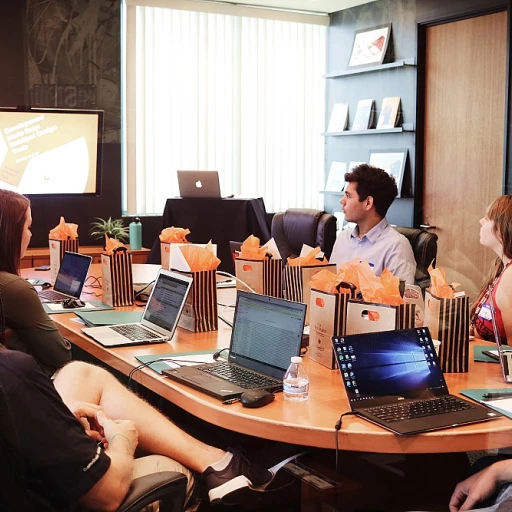
Understanding Remote Employee Engagement
Remote work has grown increasingly popular, transforming traditional workplace dynamics and posing new challenges for employee engagement. As businesses continue to navigate this evolving landscape, understanding how to keep remote teams engaged is essential. At its core, remote employee engagement revolves around establishing a meaningful connection between team members and the organization, despite the physical distance.
Recognizing the Challenges of Remote Engagement
Remote work has created a unique set of challenges when it comes to engaging employees. The absence of in-person interactions can lead to feelings of isolation and disconnect from colleagues and the company's mission. Understanding these challenges is the first step in developing effective strategies to enhance engagement in remote teams.
Moreover, remote employees often face the potential for blurred lines between their work and personal lives, which can lead to burnout if not properly managed. It's crucial for organizations to recognize these challenges and implement supportive measures to address them. Balancing work life for remote employees is an area we'll explore further, as maintaining mental well-being is a critical component of engagement.
Key Elements for Healthy Remote Engagement
Employees must feel valued, heard, and connected for engagement to thrive in a remote setting. This begins with cultivating open channels of communication, which we'll delve deeper into as the heartbeat of successful remote teams. Effective communication fosters a sense of community and ensures that employees remain informed and connected to the company's goals.
Building a strong company culture virtually is another fundamental element of remote engagement. Even without physical office space, companies can create an inclusive, supportive environment where employees feel motivated and part of a team. Virtual team-building activities, regular recognition, and feedback are all essential tools in maintaining a dynamic and engaging culture.
Innovative engagement ideas for remote workers can also infuse new energy into teams and keep employees committed and enthusiastic. By continuously exploring creative engagement strategies, companies can sustain a high level of involvement and motivation among remote employees.
Communication: The Heartbeat of Remote Teams
Why Interaction is Key in Virtual Environments
In the seamless world of remote work, communication serves as the heartbeat. Similar to how a well-organized circulation system keeps the physical body thriving, effective communication within remote teams ensures seamless operations and strengthens team spirit. When employees are dispersed across various geographies and timelines, a robust communication strategy becomes essential. Effective communication goes beyond the occasional Zoom call or the requisite weekly check-ins. It's about creating an ecosystem where every team member, regardless of their physical location, feels involved, informed, and connected. Understandably, this demand for communication heightens when teams lack physical proximity.Tools and Platforms That Foster Connection
To truly enhance communication within remote teams, it's crucial to leverage the right tools and platforms designed to create virtual connections. Popular platforms like Slack, Microsoft Teams, and Asana serve as the nerve centers for many remote teams, facilitating instant messaging, project management, and collaborative spaces. Moreover, integrating video communications such as regular video calls, virtual coffee breaks, or even setting up a dedicated channel for non-work-related chatter can work wonders in keeping the team united and engaged. This aspect aligns seamlessly with our next discussion on building a strong company culture virtually.Best Practices for Remote Team Communication
Establishing best practices for communication in remote teams is non-negotiable. Kick-starting meetings with collaborative discussions, ensuring transparency in company goals and updates, and maintaining an open-door (or open-chat) policy for concerns and ideas are integral. Equally important is the frequency of these interactions. Daily stand-ups, weekly team meetings, and monthly one-on-ones are optimal schedules to ensure that everyone is on the same page. Remember, there’s no one-size-fits-all strategy. Tailoring communication based on the team's needs will not only enhance interaction but also increase overall productivity. As we delve deeper into building a strong company culture virtually, understanding and optimizing communication plays an undeniable role in propelling remote teams toward greater engagement and satisfaction.Building a Strong Company Culture Virtually
Fostering a Connected Company Culture in a Virtual Setting
In the evolving landscape of remote work, where face-to-face interactions are replaced with digital communication, cultivating a cohesive company culture may seem daunting. However, with intentional efforts, remote teams can embrace a thriving culture that not only motivates but also retains top talent. Firstly, it's crucial to understand that company culture is a reflection of collective values, beliefs, and practices shared by the team. In a remote setting, this requires innovative strategies to bridge geographical divides. Implement Consistent Digital Rituals Regular virtual meet-ups, whether through monthly town halls or weekly casual check-ins, can significantly contribute to enhancing cultural alignment. Such digital rituals give employees a sense of belonging, connecting them with the larger mission of the company. Additionally, incorporating weekly 'happy hour' calls or virtual coffee breaks helps preserve the camaraderie and spontaneous interactions often experienced in traditional office settings. Emphasize Value-Driven Communication Values-driven communication policies do wonders in reinforcing a remote team's culture. Encouraging open feedback channels and employee recognition programs can help foster an atmosphere of trust and appreciation. This approach not only bolsters engagement but enhances each team member's intrinsic motivation to contribute positively to the organization. Leverage Technology for Seamless Integration Investing in technology tools that facilitate effortless communication and collaboration is vital for embedding engagement practices into a virtual culture. Tools such as collaborative project platforms, feedback apps, and digital recognition systems can prove invaluable for keeping remote teams engaged and aligned with company goals. For insights on how HR can drive engagement to boost company success, exploring strategies for aligning company values can be beneficial. Encourage Cross-Departmental Collaboration Finally, facilitating opportunities for cross-departmental projects and social interactions can contribute immensely to a robust company culture. Encouraging employees from different teams to work together on shared goals not only fosters innovation but also breaks down silos, offering a holistic view of the company's operational ecosystem. Establishing a vibrant company culture in a virtual environment may require a tailored approach, but with strategic planning and continuous engagement efforts, remote teams can experience a sense of unity and purpose akin to their in-office counterparts. Let these elements guide your efforts and witness the unfolding of a flourishing remote work culture.Engagement Ideas for Remote Workers
Creative Ways to Keep Remote Employees Engaged
Keeping remote employees engaged is essential for a cohesive and productive team. After understanding the fundamentals of engagement and communication, and nurturing a vibrant virtual company culture, it's time to delve into creative strategies that cater to the diverse needs of remote workers. One effective idea is organizing virtual team-building activities. Online games, virtual coffee breaks, and themed dress-up days can infuse a dose of fun into the workweek, fostering camaraderie and breaking the monotony of remote work. These activities can be tailored to accommodate different time zones and preferences, ensuring inclusivity for all team members. A focus on professional development opportunities is another vital strategy. Encouraging employees to engage in online courses, webinars, and workshops not only enhances their skills but also demonstrates your investment in their growth. Consider setting up a "lunch and learn" session where employees can share insights from the courses they've attended. Recognition and rewards are powerful motivators. Implementing a system for acknowledging employee contributions, be it through digital badges, shout-outs in team meetings, or a "remote employee of the month" award, can greatly boost morale and engagement. Lastly, creating channels for open feedback allows employees to voice their concerns and suggestions. When employees see their feedback being acted upon, it instills a sense of trust and belonging. With a little creativity, keeping remote employees engaged can be an enriching experience for everyone involved, paving the way for sustained success in a digital workspace.Balancing Work Life for Remote Employees
Navigating the Balance in a Remote Setting
In remote work settings, the line between personal and professional life often blurs, making it crucial to ensure that employees can effectively balance their work and home responsibilities. Achieving this balance is not only beneficial for the individual's wellbeing but also significantly contributes to sustained employee engagement. Creating flexible work schedules is one of the most effective ways to promote balance. Allowing team members to tailor their work hours around their peak productivity periods or personal obligations not only enhances job satisfaction but also facilitates better work performance. When employees feel supported in managing their time, their commitment to the team naturally increases. Moreover, setting clear expectations and boundaries is essential. Encourage open communication about workloads and deadlines, and ensure that employees are not overwhelmed with tasks outside of regular working hours. Establishing and respecting these boundaries fosters an environment where employees feel their life outside of work is valued, thus improving their overall engagement. Another aspect to consider is providing resources and support for mental health. Employers should consider offering access to wellness programs or mental health days as part of their employee benefits, as these can significantly enhance workplace morale and engagement levels. As highlighted in the section about the role of managers, leaders play a pivotal role in maintaining this balance. They should champion the cause of proper work-life standards, leading by example, and encouraging their team to take necessary breaks to avoid burnout. Lastly, incorporating virtual social breaks can also diminish the monotony of remote work. These can take the form of virtual coffee breaks or team-building activities mentioned in the section on engagement ideas. Such initiatives not only boost morale but also provide a platform for employees to bond over shared interests, further nurturing a sense of community within the remote team.The Role of Managers in Remote Team Engagement
Empowering Leadership in Remote Settings
Managers play a pivotal role in fostering engagement within remote teams. As we explored earlier, communication is the lifeblood of any team, but it takes on added significance in a remote environment. Managers must ensure that communication channels are not only open but also effective, facilitating a flow of information that is both transparent and inclusive.
One of the key responsibilities of managers is to cultivate a virtual company culture that resonates with remote employees. This involves creating a sense of belonging and shared purpose, which can be challenging when team members are scattered across different locations. However, by leveraging technology and innovative strategies, managers can build a cohesive culture that aligns with the company's values and goals.
Moreover, managers should focus on providing regular feedback and recognition, which are crucial for maintaining motivation and morale among remote workers. Personalized feedback sessions can help employees feel valued and understood, while public recognition in virtual meetings can boost team spirit and encourage a culture of appreciation.
Balancing work-life dynamics is another area where managers can make a significant impact. By promoting flexible work schedules and respecting personal boundaries, managers can help remote employees achieve a healthy balance, ultimately leading to higher engagement and productivity.
In summary, the role of managers in remote team engagement is multifaceted, requiring a blend of communication skills, cultural sensitivity, and a commitment to employee well-being. By embracing these responsibilities, managers can create an environment where remote employees feel connected, supported, and motivated to contribute their best work.













